Are you concerned about the age of your tires?
This quick guide will help you find the manufacture date of your tire and understand how Tires Easy handles tire age based on the DOT Code. Keeping a record of your tires and understanding their age will help you save money on repairs and take proper care of your vehicle.
To find your tires’ age, you need to locate the DOT Date Code on the tire. This symbol indicates the tire manufacturer’s compliance with the U.S. Department of Transportation (DOT) National Highway Traffic Safety Administration (NHTSA) safety standards. It tells you who manufactured the tire, where it was made, and other tracking information. Plus, it indicates that the tire has passed the Department of Transportation’s testing and NHTSA manufacturer requirements.
The raised numbers of the DOT Code are placed together and often enclosed in a raised oval. The first two numbers are the week the tire was manufactured. In the example below, 35 stands for “week 35.” The second two numbers are the year the tire was manufactured. In the image below, we see the 07, indicating the tire was build in 2007. This particular tire was made in the 35th week of 2007.
On tires that were manufactured in 2000 and after, the last four digits indicate the week and year the tire was produced. The first two digits identify the week and the second two identify the year.
It’s not always easy to find the tire DOT code. There aren’t regulations on where the manufacturer has to place the information, so you may need to look at multiple sides of your tires before you can find the numbers. However, the identification information is usually on the inner sidewall of tires.
At Tires Easy, we believe that the tire warranty should begin from the date of purchase, not the DOT Code. If you purchase new tires today, and the DOT Code was a year ago, your warranty will still begin on the purchase date, not the manufacture date of the tire.
If you purchase new tires today, and the DOT Code was a year ago, your warranty will still begin on the purchase date, not the manufacture date of the tire.
If for any reason you are uncomfortable with the age of your tires after looking at the DOT Date code, please call us and we can quickly provide you with a return under our 45 day return policy.
Just because you buy “new” tires doesn’t mean they were actually made recently. It can take a while for tires to reach tire retailers after being shipped from the manufacturer. Checking your tires’ DOT Date Code will tell you when they were made and how long they may have been stored. It is important to know that tires are often for months or years at a time, so your tire’s DOT code might not be in the same year you bought the tires, and that’s not a concern.
At Tires Easy, we take tire protection VERY seriously. Once the tires reach us, they are moved into Tires Easy’s industrial tire warehouses to ensure proper storage and prevent exposure to seasonal weather conditions. Our storage locations are cool, climate-controlled, and dry, preventing any premature aging or damage. Tire aging can be rapidly accelerated by poor storage conditions, so you should be sure the tires you purchase have been properly stored.
Our storage locations are cool, climate-controlled, and dry, preventing any premature aging or damage. Tire aging can be rapidly accelerated by poor storage conditions, so you should be sure the tires you purchase have been properly stored.
A general consensus from various tire industry associations around the world is that tires have a useful service life of six to ten years. As technology changes, there are more materials, and combinations of comounds, to extend tire life and extend wear. At Tires Easy, we like to err on the side of caution and only sell tires that are seven years old and under. If you consider that the average driver travels 15,000 miles per year, most tires need to be replaced in 4 years. If your tires were a few years old when purchasing, you would still be well within the accepted tire age range. This is especially true if the tires receive the proper amount of care and maintenance over the course of their lifetime.
Legally, you must replace your tires when the tread depth falls below 1.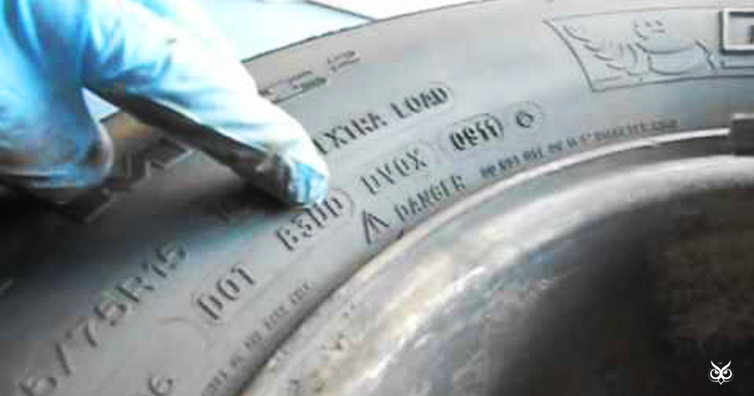 6 mm. Additionally, it’s recommended that you change summer tires at 3 mm and winter tires at 4 mm tread depth. This keeps your tires at optimal levels of safety.
6 mm. Additionally, it’s recommended that you change summer tires at 3 mm and winter tires at 4 mm tread depth. This keeps your tires at optimal levels of safety.
When your tires reach seven years of age, we recommend that you consider replacing them. Even if the tires look new, it is best to have them inspected by a professional tire installer, so they can properly advise on the safety of the tires moving forward. Spare tires should be checked and replaced as well.
No matter how old the tires are when you buy them, the most important aspect of tire safety is regular maintenance and inspection. According to the The Rubber Manufacturer’s Association of America and the Tire & Rubber Association of Canada.
“Since service and storage conditions vary widely, accurately predicting the service life of any specific tire based on calendar age is not possible.”
For this reason, there is no specific limitation on the age of the tire when it is sold based on its DOT Code.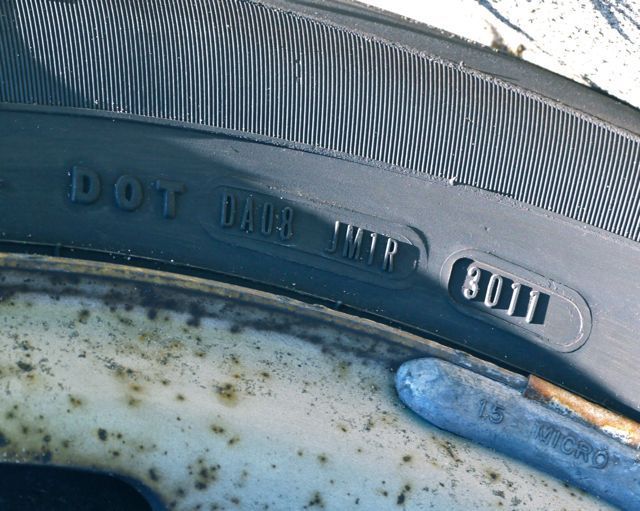
1. In terms of the DOT Date Code, some might assume that the number states when the tire was approved. On the contrary, the DOT symbol by itself simply indicates that the tire is approved by the Department of Transportation to be legally used on the road. The Date Code is when the tire was manufactured (not when it was approved).
2. You might also have heard that you should only buy tires that have a DOT code within the current year. As we mentioned earlier, this is often not the case with many tires simply because it takes time for the tire to reach the United States from the manufacturer. As long as the tires have been stored properly, they will be in excellent condition, even if the DOT Date code is a couple of years old.
When stored properly and protected from the elements, tires age quite slowly. The Rubber Manufacturers Association has said there’s no way to put a date on when tires actually “expire.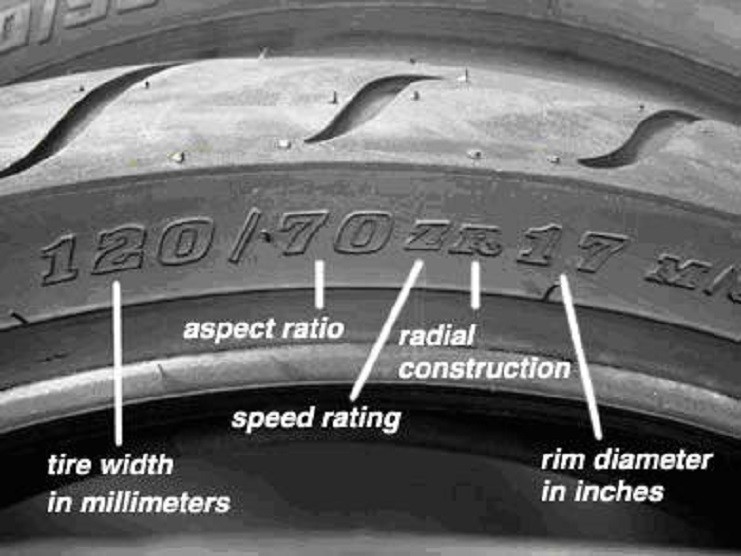 ” There are too many factors that impact the true age of a tire.
” There are too many factors that impact the true age of a tire.
To help prolong the life of a tire, tire retailers will:
While these are the main contributors to excessive tire aging, it would still take years of exposure in the hottest, wettest, and driest climates for the first signs of tire aging to appear. Tires are durable, and if they’re showing signs of damage within the first few years, it’s a sign of poor quality. Whitening of the rubber and shallow hairline cracks in the upper or lower sidewall may be an indication of UV and heat damage, but these symptoms aren’t issues you commonly see in new tires.
Sidewall cracking due to UV rays
Yes, the rubber gets hard over time as the tire loses its elasticity.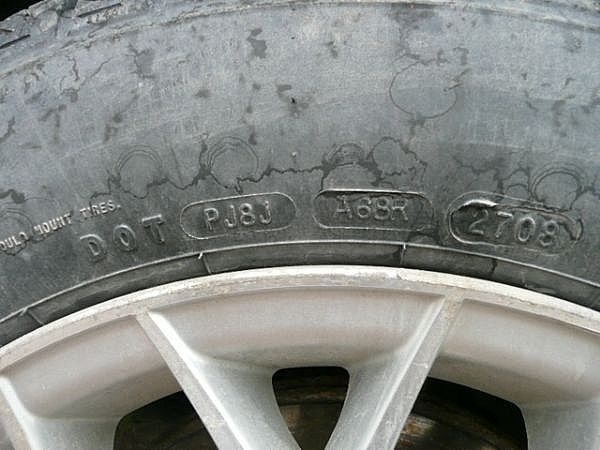 This happens regardless of how much you use your tires over the course of the years.
This happens regardless of how much you use your tires over the course of the years.
Every tire has a birthday, and many tires will not be sold 7 years later. However, since some tires don’t technically become unsafe until a decade after they’re produced, the best advice is to have your tire checked by a professional to make sure they are safe for continued driving.
If you have any questions about your tire’s DOT Code or tire age in general, get in contact and let us assist you!
Check out our specially priced tire selection in limited quantities and period of time
The U.S. Department of Transportation (DOT) number stamped on the tire’s sidewall contains a date code that identifies the age of your tires. This DOT number (also called the Tire Identification Number or TIN) is contained in a sequence of up to 12 letters and numbers that signify the tire size, the manufacturer, the specific plant where it was built and when it was built.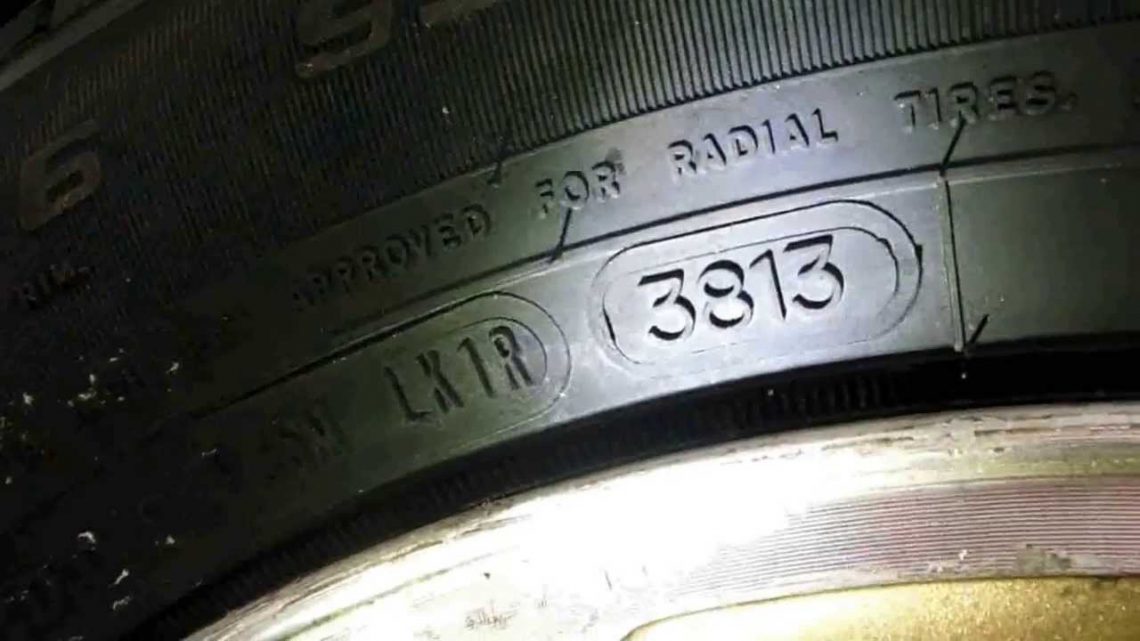 In the event of a recall, tiremakers and the National Highway Traffic Safety Administration use the DOT number to identify which defective tires are in the campaign. The date code used on tires is not a typical representation used for dates and can be easily missed by the untrained eye.
In the event of a recall, tiremakers and the National Highway Traffic Safety Administration use the DOT number to identify which defective tires are in the campaign. The date code used on tires is not a typical representation used for dates and can be easily missed by the untrained eye.
To determine the age of your tires, check the last four digits of the U.S.
Tires built from 2000 to the present use the last four-digits of the DOT number to identify the week and year of manufacture. For example, a DOT number with 4116 at the end of the sequence would mean that the tire was manufactured in the 41st week of 2016, or sometime in the mid-October.
While it is increasingly rare to find a tire made before 2000, these tires use only three digits in the date code for the week and year. A tire with a three-digit date code like 416 means that the tire was made in the 41st week of 1996.
Tire DOT Numbers Include a Date Code
(Source: National Highway Traffic Safety Administration)
Be aware that the complete tire DOT number is not required to be molded on both sides of the tire.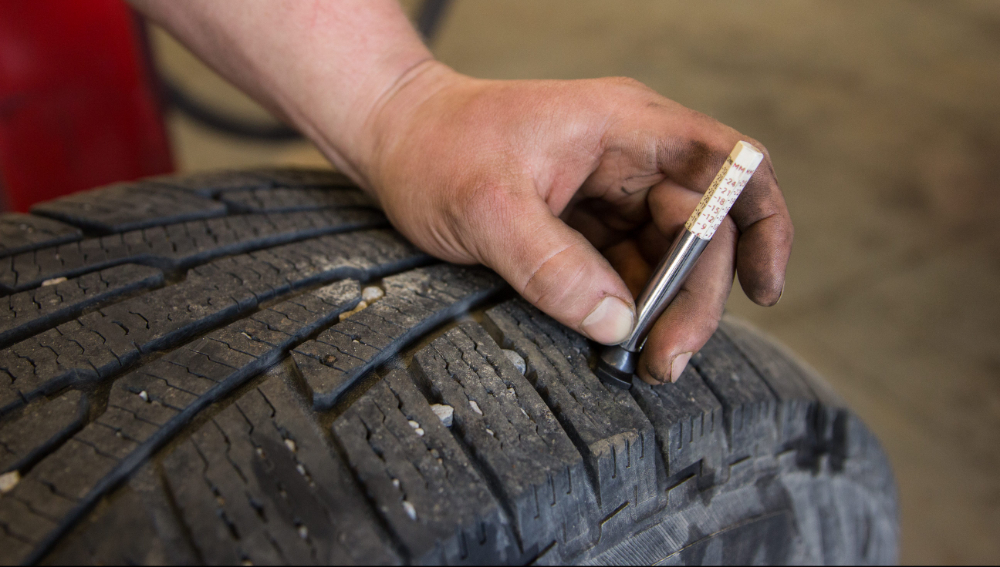 While some tire makers include the full DOT number on both sides, the date code on your tires may only be contained on one side. If the DOT number is only eight characters, you’ll need to look on the other side of the tire to find the full number with the date code.
While some tire makers include the full DOT number on both sides, the date code on your tires may only be contained on one side. If the DOT number is only eight characters, you’ll need to look on the other side of the tire to find the full number with the date code.
Why is it important to understand your tire’s age? Manufacturers have known for decades that exposure to heat and oxygen weakens rubber over time. Today’s tires are highly engineered products, with anti-aging chemicals mixed in the rubber compounds, along with others to make the rubber softer and more flexible. But, over time, the rubber and component materials within the tire changes and becomes more prone to failure. In most instances this loss of strength is invisible – and the material degradation is present regardless of tread depth and even in tires that have never even been put on a vehicle
Aged tires are more susceptible to catastrophic tread separations, which occurs when the tire’s outer layer separates from the tire body or casing.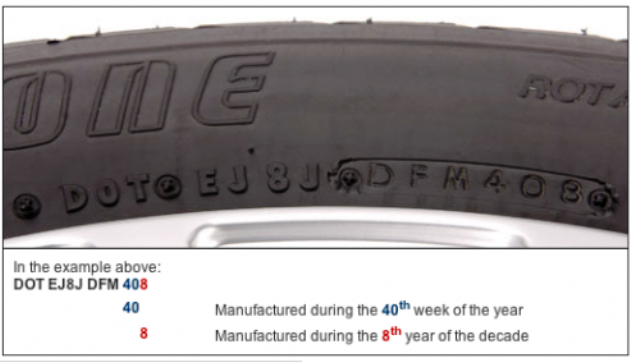 This type of failure can be much more dangerous for drivers to manage than a flat tire or blow out, particularly in trucks, SUVs and vans – particularly 15-passenger vans – because they are more prone to handling and stability problems.
This type of failure can be much more dangerous for drivers to manage than a flat tire or blow out, particularly in trucks, SUVs and vans – particularly 15-passenger vans – because they are more prone to handling and stability problems.
While tread separations caused by manufacturing defects can occur in new tires, tires older than six years – especially those on vehicles located in hot-weather states such as if such as Arizona or Florida – are more prone to suffer a catastrophic tread separation.
According to the National Highway Traffic Safety Administration “Most vehicle owners can easily overlook tire aging, increasing their risk of a crash.”
Based on research showing that the rate of tire failures increases after six years, nearly all vehicle manufacturers recommend owners replace tires after six years, regardless of tread depth. Most tire manufacturers recommend replacement at 10 years or that owners follow the vehicle manufacturer’s guidelines.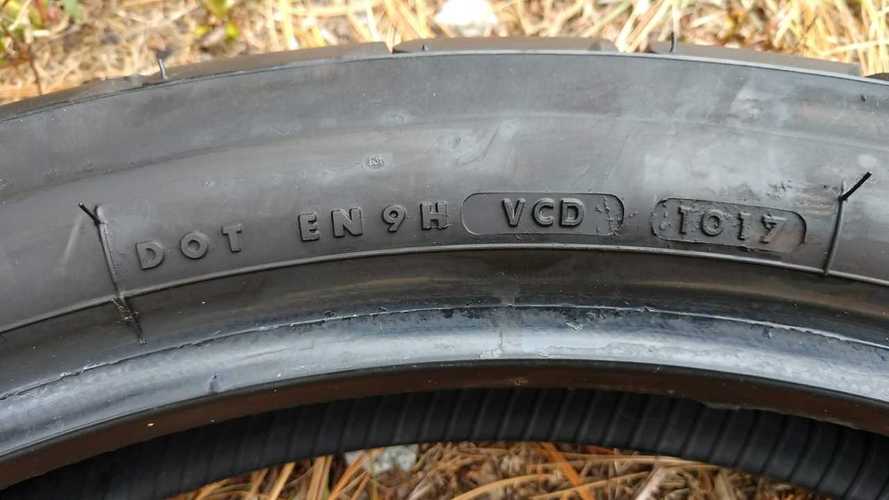 Tire makers continue to insist that expiration dates are not necessary, yet, nearly all passenger and light truck tire warranties expire at six years. Some tire retailers have also adopted the tire age recommendations and will not service vehicles with tires that are beyond the manufacturers age recommendation.
Tire makers continue to insist that expiration dates are not necessary, yet, nearly all passenger and light truck tire warranties expire at six years. Some tire retailers have also adopted the tire age recommendations and will not service vehicles with tires that are beyond the manufacturers age recommendation.
Consumers should also check the DOT code when buying new replacement tires. Some retailers will sell a “new” tire that has actually been sitting in their inventory for years. That tire could have been improperly stored in a warehouse or outdoors exposed to high temperatures that reduce a tire’s robustness and useful life.
Consumers should insist on replacement tires manufactured within months of the purchase date. And, regardless of tread depth, vehicle owners should replace their tires six years and older.
Call us if you believe a defective tire caused your accident. The team at Newsome Melton can review the facts of your case and determine if we believe you have a valid claim for compensation. If we feel you have a strong defective tire case against the manufacturer, we can navigate the claims process on your behalf and potentially recover compensation to pay for your medical bills, lost wages, vehicle repair or replacement, or other losses.
If we feel you have a strong defective tire case against the manufacturer, we can navigate the claims process on your behalf and potentially recover compensation to pay for your medical bills, lost wages, vehicle repair or replacement, or other losses.
Call us today at 888-221-5316 or contact us through our online chat. We offer free reviews and handle many of these claims on a contingency fee basis. This means we do not recover compensation unless you do.
It is not difficult to find out the year of manufacture of a tire. One careful look at the sidewall of the tire is enough to get the necessary information.
The year of manufacture of the tire is indicated next to other indicators in an oval frame. The whole series of these designations is called the Tire Identification Number. It carries information about the year of production, the batch of product with which this tire was released.
Contents
Starting from 2000, a four-digit number is indicated in the oval, which is the year of manufacture. The first two digits are the week number of the year, and the second two numbers are the year of issue itself. For example, if the sidewall of the wheel says - 2415, then this is the 24th week of 2015. If we are talking about tires manufactured before 2000, you need to act differently. The identification number of a tire produced before 2000 is calculated that it will not be used for more than ten years.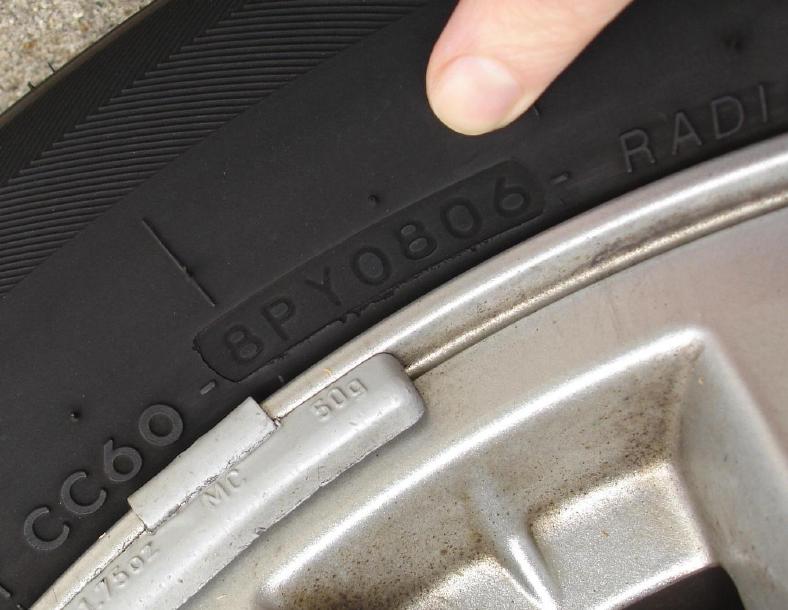 That is why all information is encrypted differently. The last three digits of the number are the production date. The last digit is the date of the current decade. The penultimate 2 digits are the week number. And if we have a number - 258, then - the 25th week, the 8th year.
That is why all information is encrypted differently. The last three digits of the number are the production date. The last digit is the date of the current decade. The penultimate 2 digits are the week number. And if we have a number - 258, then - the 25th week, the 8th year.
Yes! Everything has its own expiration date and use. Tires are far from an exception. 3 years is the standard for absolutely all tires of any kind. For its storage, special conditions are necessary, since the rubber compound, over time, may lose its properties. Loss of elasticity gives cracks throughout the wheel, from which riding on such a tire becomes unsafe. Even if the tires were stored in compliance with absolutely all standards, but for a period of more than three years, this does not give a reason not to check it for integrity. In order to protect yourself and others, you must check the date of manufacture of the tire before purchasing it.
Unfortunately, the sellers go to any tricks to sell their goods, and even assure that this is absolutely not the right indicator.
Not uncommon, in the markets you can find a product from past seasons. Such tires are bought in bulk for resale in other markets marked - "New". And everything would be fine, but such methods of sales lead to many factors that adversely affect the quality of the product. The problems are - the storage conditions of tires and their transportation from the place of their sale to the resale markets.
Everyone must find out for himself when exactly it is time to change it. We must not forget that a tire is a mixture of various chemical elements, which can be influenced by factors of various types. From driving speed and driving style to climate. Loads can be completely different, so their time can vary and it is impossible to predict it.
It is necessary to regularly inspect the wheels, both on your own and use the help of specialists in tire centers or seek help directly from the supplier, who will be able to point out exactly the faults, if any.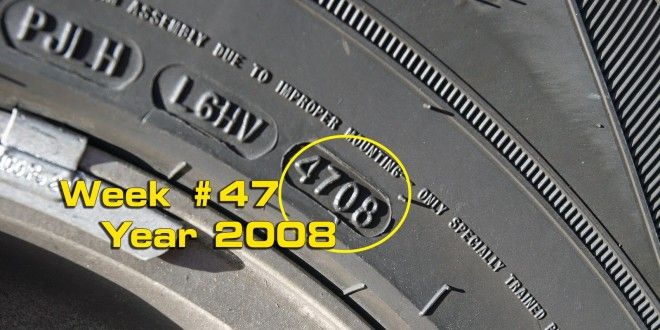 This rule applies to passenger car tires, as well as to trucks and public ones. Don't forget about the spare too.
This rule applies to passenger car tires, as well as to trucks and public ones. Don't forget about the spare too.
After 5 years of operation, tire diagnostics should be carried out at least once a year.
It is very important to pay attention to any changes in the car such as:
Professional diagnostics will help you decide on the condition of the tires, whether they should be repaired or replaced altogether.
You can absolutely say for sure - It is impossible to predict the end of the operational life of a tire only with the help of a calendar, since they do not have an exact expiration date. But the fact remains unchanged that the older the tire, the more it becomes unusable, defects appear, changes that affect its condition.
If there are doubts about the quality of the tire after a certain period of use, the best solution is to replace the entire set together with the spare wheel.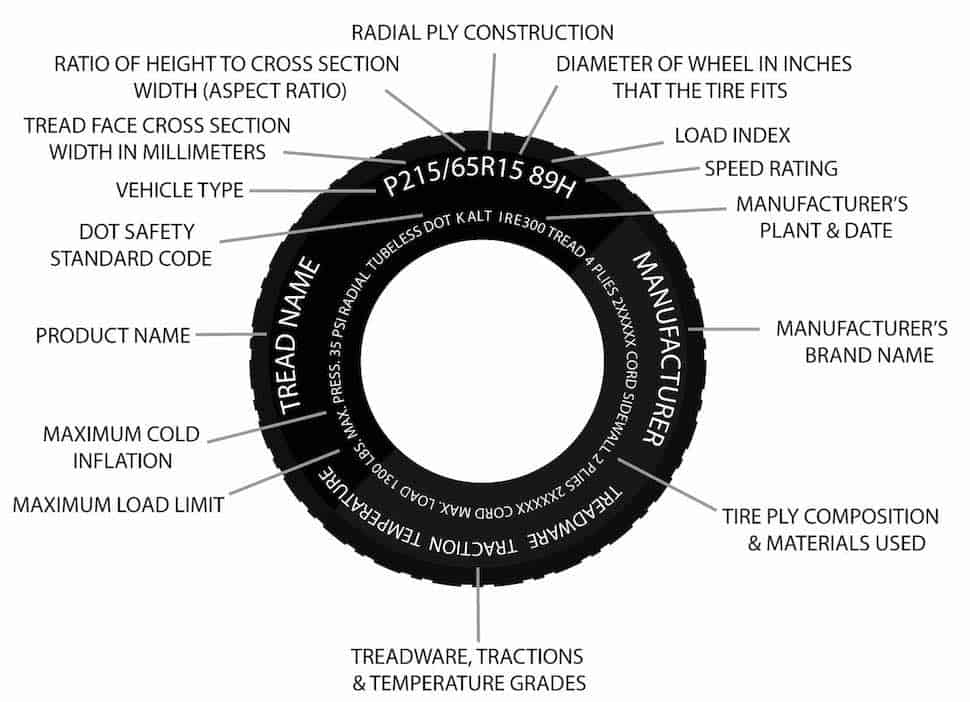 On the last, you should pay as much attention as possible. Due to long-term uselessness, and not always proper storage, it may become cracked, which is the first sign
On the last, you should pay as much attention as possible. Due to long-term uselessness, and not always proper storage, it may become cracked, which is the first sign
Pay attention to the tire manufacturer. Big companies spend a lot of effort doing a lot of research on tire wear and life. A company like Bridgestone owns a large number of research and scientific centers around the world.
If we are talking about buying a used product, then you should pay attention to the wear of the protectors and appearance. Check for cracks.
Well, the last point - Check the tire for signs of repair, scuffs and bumps at the base of the rim. So you can check how it was used before you and how it was stored in warehouses.
Don't know how old your tires are and don't know where to look for the date of manufacture of tires? Don't worry - this is a common problem.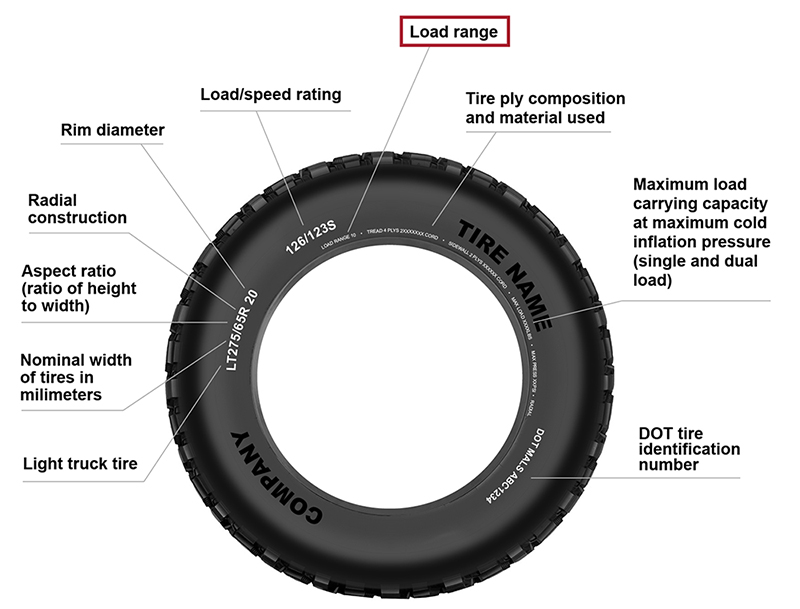 We can show you the date of manufacture of a tire and teach you how to quickly find out the date of manufacture of your tires.
We can show you the date of manufacture of a tire and teach you how to quickly find out the date of manufacture of your tires.
You can find out the year of manufacture of rubber on the sidewall of the tire in an oval stamp in the form of 4 digits, for example: 1612. The first two digits mean the week of manufacture, the last two - the year. In our case, week 16 is April 2012.
If you look closely at each of your tires, you'll see a bunch of letters and numbers. While this may just look like confusion, it's actually useful information. Look for a number that begins with the letters "DOT" followed by a series of 10-12 characters. This code, which is required by the US Department of Transportation (DOT) and applies worldwide, will tell you a few things:
The date of manufacture is the last four digits of the DOT code. The first two digits are the week of manufacture and the last two digits are the year. For example, if the last four digits of the DOT code are 0203, this means that the car tire was manufactured during the second week of 2003. Pretty simple, right? However, if your tires were made before 2000, things get a little more complicated.
The first two digits are the week of manufacture and the last two digits are the year. For example, if the last four digits of the DOT code are 0203, this means that the car tire was manufactured during the second week of 2003. Pretty simple, right? However, if your tires were made before 2000, things get a little more complicated.
The date of issue is the last three digits of the code. The first two digits refer to the week in that year. For example, if the last 3 digits are 022, this means that the car tire was produced in the second week of the year, and the year is the second year of the decade. Here's where it gets confusing - there's no universal identifier that specifies which decade, so in this example, the tire could have been made in 1982 or 1992. Some tires have a small triangle following the DOT code to indicate 1990s.
If you look at the sidewall of the tires and see a DOT number that seems incomplete, it's because current DOT regulations require the entire number to be on only one sidewall, while only the first few digits are on the opposite sidewall. To see the entire DOT number, just look at the other side wall.
To see the entire DOT number, just look at the other side wall.
After five years of storage, tires lose their performance, regardless of whether the storage conditions were observed or not. Therefore, it is not recommended to use car tires with a manufacturing date older than five years.
The average shelf life of tires, declared by the manufacturer, is 7-10 years, depending on seasonality - harder summer tires on a car last longer than soft winter ones.
Amtel, Barum, Bridgestone, Continental, Cooper, Cordiant, Dayton, Debica, Goodyear, Dunlop, Falken, Firestone, Fulda, General, Gislaved, Hankook, Kama, Kelly, Kleber, Kormoran, Kumho, Marshal, Matador, Maxxis, Michelin, Nitto, Nokian, Pirelli, Sava, Semperit, Tigar, Triangle, Toyo, Uniroyal, Yokohama.
However, don't pay too much attention to the age of the tires when buying, especially if they are less than two years old.